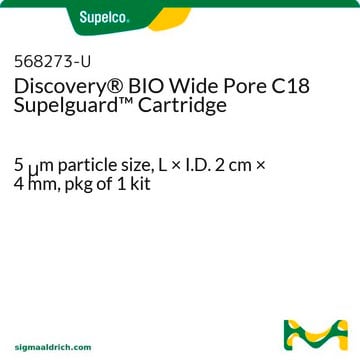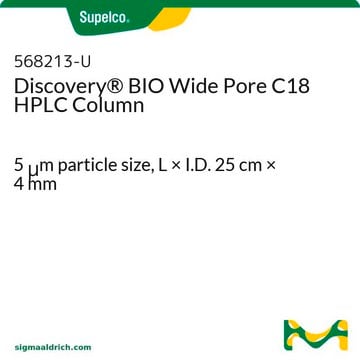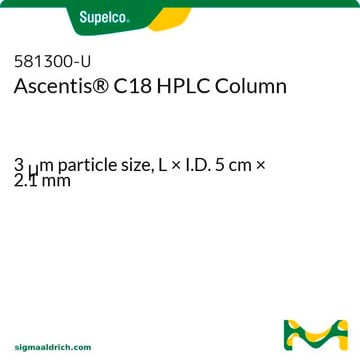Reverse Phase Column Rehydration Method:
1. The column should ideally not contain any buffer. If it does, thoroughly flush the column with water to remove the buffer.
2. Flush the column with 100% acetonitrile, starting at a flow rate of 0.3-0.5 ml/minute. Slowly increase the flow rate to 1 ml/minute, flushing for approximately 30 minutes, as long as the pressure does not excessively increase.
3. Equilibrate the column with the mobile phase specified on the Certificate of Analysis (CofA) of the column, and run a test mix similar to what was used to test the column.
4. If the performance is unsatisfactory, repeat the method, increasing the flushing with acetonitrile for one hour.
5. Repeat the test. If the performance is still not as expected, the column may have degraded.
推薦產品
產品名稱
Discovery® BIO 大孔 C18 高效液相色谱柱, 5 μm particle size, L × I.D. 25 cm × 4.6 mm
材料
stainless steel column
agency
suitable for USP L1
產品線
Discovery®
特點
endcapped
製造商/商標名
Discovery®
包裝
1 ea of
標籤範圍
9.2% Carbon loading
參數
0-70 °C temperature
400 bar pressure (5801 psi)
技術
HPLC: suitable
LC/MS: suitable
長度 × 內徑
25 cm × 4.6 mm
表面積
100 m2/g
表面覆盖率
3.6 μmol/m2
基質
silica particle platform
fully porous particle
基質活性組
C18 (octadecyl) phase
粒徑
5 μm
孔徑
300 Å
工作pH值
2-8
分離技術
reversed phase
尋找類似的產品? 前往 產品比較指南
一般說明
應用
- 采用梯度动力学图比较表面多孔、全多孔和整体反相色谱柱在蛋白质生物药物分离中的动力学性能。:本研究对Discovery® BIO大孔C18 HPLC柱等不同类型HPLC反相色谱柱进行了详细的动力学性能比较。研究重点介绍了色谱柱分离复杂蛋白质生物制药方面的效率和分辨率,使其成为分析化学家在生物制药分析中的宝贵工具(Jaag et al., 2022)。
- 使用全多孔和部分多孔固定相组合对胰蛋白酶消化物进行RP-LC x RP-LC分析。:本文研究了使用配备全多孔和部分多孔固定相(包括BIO大孔C18 HPLC色谱柱)的反相液相色谱(RP-LC)分析胰蛋白酶消化物。研究结果证明,它在蛋白质组学应用中具有稳健性和高分辨率,能够实现精确的肽图分析和蛋白质表征(Mondello et al., 2010)。
法律資訊
客戶也查看了
相關內容
DiscoveryBIO Wide Pore C18 products offered by Sigma-Aldrich.
DiscoveryBIO Wide Pore C18 產品由 Sigma-Aldrich 提供。
Chromatograms
application for HPLC-
What is the method for rewetting a column that may have dried as a result of the end cap being loose or not being used for an extended period of time?
1 answer-
Helpful?
-
-
WHIGH SOLVENT USED FOR WASHING OF COLUMN
1 answer-
See below for a general cleaning protocol:
1. Reverse the orientation of the column
2. Flush for a few minutes, or >1 column volume, with a 20% solution in water, of the organic used in the analysis, such as methanol or acetonitrile. This is to remove any residual buffer salts.
3. Flush for approximately 30 mins, or >10 column volumes, with 100% of the organic solvent used in the analysis.
4. The column can be stored with this organic solvent until ready for use.
5. Before reusing the column, flush again, as per step 2.Helpful?
-
Active Filters
我們的科學家團隊在所有研究領域都有豐富的經驗,包括生命科學、材料科學、化學合成、色譜、分析等.
聯絡技術服務










